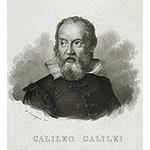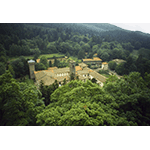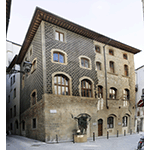Meteorology in Florence

The use of instruments that had now become common, such as the thermometer and the barometer, results from the ingenious intuition of the seventeenth-century Tuscan scientists. Thanks to these instruments it was possible to predict and study the evolution of the weather, with important benefits for agriculture as well. From these bases, one of the oldest meteorological observatories in Europe still active today there was established in Florence in the early 19th century.

The origins of scientific meteorology
The scientific work of Galileo Galilei and his disciples led to radical changes in the study of atmospheric phenomena, traditionally treated as sterile comment to Aristotle's texts or merely as a collection of observed data. Modern meteorology, considered to be the science that deals with the terrestrial atmosphere and the phenomena occurring in it, originated in fact at the Medicean court in Florence.
Torricelli's experiment
The experiment conducted by Evangelista Torricelli in 1644 demonstrated the existence of the vacuum, inaugurating an intense period of barometric research culminating in the studies of Giovanni Alfonso Borelli on the connection between barometric variations and climate. The experiment led to the invention of the barometer, one of the most important meteorological instruments.
Instrumental meteorology
In the 17th century not only the barometer but also the thermometer was invented, and the hygrometer, anemometer and pluviometer were perfected. Instrumental meteorology originated and was definitively established within the sphere of the Accademia del Cimento (1657-1667). The Galilean thermoscope was given a scale and transformed effectively into a thermometer. Galilean thermometers, fabricated by skilful technicians known as "Gonfia", predominated for years in the scientific community. Francesco Folli da Poppi, Vincenzo Viviani, and even Grand Duke Ferdinand II designed hygrometers of various types, while Benedetto Castelli designed an efficient pluviometer.
-
 Benedetto Castelli
Benedetto Castelli -
 Ferdinand II de' Medici
Ferdinand II de' Medici -
 Francesco Folli
Francesco Folli -
 Vincenzo Viviani
Vincenzo Viviani -
 From the thermoscope to the thermometer
From the thermoscope to the thermometer -
 Hygrometer
Hygrometer -
 Thermoscope
Thermoscope -
 Windvanes and anemometers
Windvanes and anemometers -
 Court Scientists. The Art of Experimentation in the Accademia Galileiana del Cimento (1657-1667)
Court Scientists. The Art of Experimentation in the Accademia Galileiana del Cimento (1657-1667)
-
 Museo Galileo - Room VIII. The Accademia del Cimento
Museo Galileo - Room VIII. The Accademia del Cimento
-
 Viviani's rope hygrometer
Viviani's rope hygrometer
-
 Condensation hygrometer
Condensation hygrometer

Synoptic meteorology
In 1654 Grand Duke Ferdinand II instituted the first meteorological network, an event of fundamental importance for the development of meteorology. In the period ranging from 1654 to 1667, Luigi Antinori coordinated, in fact, an observational network consisting of Italian and foreign observation stations. This was the first attempt to systematically collect observational, descriptive and instrumentational data coming from different geographic localities, through the utilisation of homogeneous instruments and the adoption of observation procedures as uniform as possible. The revolutionary aspect of this scientific undertaking promoted by Grand Duke Ferdinand II consisted expressly in the adoption of this method, more than in the actual comparability of the meteorological data coming from the observation stations: from nearby Vallombrosa, as well as from distant Warsaw and Innsbruck.

Meteorological research in the 18th century
During the 18th century the great Florentine meteorological tradition continued, although in a minor key, thanks to the activity of the Accademia dei Georgofili and the Imperiale e Regio Museo di Fisica e Storia Naturale [Imperial and Royal Museum of Physics and Natural History] in Florence. Interest in studies on atmospheric phenomena was linked in great part to Leopold's reform project for the development of agriculture in Tuscany. The work of scientists such as Giovanni Fabbroni and Giovanni Targioni Tozzetti laid the grounds for modern agricultural meteorology.
Meteorological research in the 19th century
In the early years of the 19th century an important centre of meteorological studies was represented by the Ximenian Observatory, where since 1813 meteorological observations had no longer been irregular or subordinated to astronomical observations. In that year, in fact, the director of the time, Giovanni Inghirami, inaugurated a Meteorological Observatory that is still active today.
In 1839 Vincenzo Antinori, director of the Florence Museo di Fisica e Storia Naturale and convinced believer in the importance of meteorology, promoted and set up the Central Italian Meteorological Station. His project, presented at the Congresses of Scientists held in the first half of the 19th century, concluded in 1858 with the publication of the Central Italian Meteorological Archive.
Two years later the spectacular thermometer and barometer of Filippo Cecchi was installed under the Loggia dell'Orcagna. The mechanisms and dial of this instrument are found today in the Florence Istituto e Museo di Storia della Scienza. In 1883 Florence was chosen, in homage to its indisputably central role in the history of meteorology, as site of the first Congress of the Meteorological Society.
****************************
Texts by Stefano Casati
English translation by Catherine Frost
Last update 25/feb/2008


